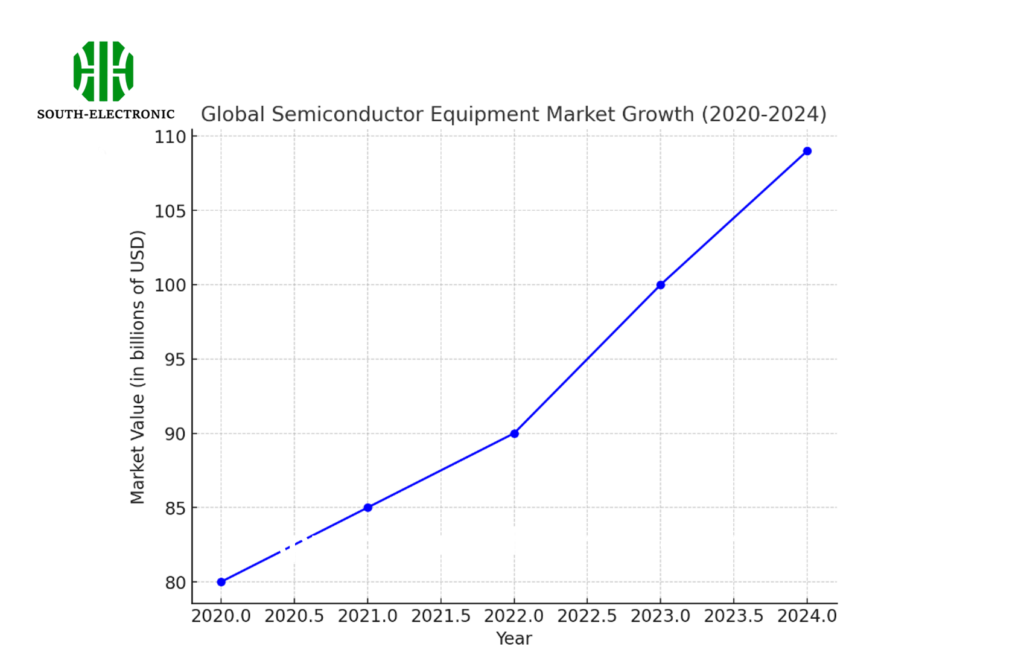The global semiconductor equipment market is poised for another exciting year in 2024. In Q2 2024, global semiconductor equipment billings grew by 4%, reaching $26.8 billion. This growth reflects a recovery from previous challenges, including material shortages and logistical delays that affected the market in 2022 and 2023. While year-over-year growth in Q2 2024 was moderate, certain regions are outperforming others, leading to both opportunities and challenges for manufacturers and investors alike.
However, the growth pattern across regions remains varied. For instance, North America has demonstrated robust growth, thanks to heavy investments in advanced chip manufacturing technologies, while Europe and parts of Asia are recovering more slowly, affected by ongoing economic uncertainties and geopolitical tensions.
Semiconductor Equipment Billings by Region (Q2 2024)
| Region | Billings ($ Billion) | Year-over-Year Growth (%) |
|---|---|---|
| North America | 9.2 | 5% |
| Asia | 10.5 | 3% |
| Europe | 2.8 | 1% |
| Other Regions | 4.3 | 4% |
| Total | 26.8 | 4% |
Regional Performance
North America
The North American semiconductor equipment market is performing well, primarily driven by investments in advanced manufacturing capabilities and a focus on the production of next-generation chips. The U.S. government’s CHIPS Act, which aims to boost domestic semiconductor production, is expected to contribute to further growth in the region. Investment in research and development, coupled with collaboration between private industry and government initiatives, will likely sustain the region’s upward momentum throughout the rest of 2024.
Asia
Asia remains the largest player in the global semiconductor equipment market, particularly Taiwan, South Korea, and China. Taiwan continues to dominate due to its advanced chip-making capabilities, while South Korea has emerged as a global leader in memory chips. China’s growth in semiconductor manufacturing remains constrained by ongoing trade restrictions and sanctions, but the country is investing heavily in developing its own chipmaking infrastructure.
Europe
Growth in Europe has been more muted, partly due to economic challenges and reliance on external supply chains. However, the European Union is working to increase its share of global semiconductor production by promoting local manufacturing initiatives. The European Chips Act, modeled on the U.S. initiative, aims to reduce reliance on foreign producers, particularly in critical industries like automotive electronics.
Technological Trends Driving the Market
- Advanced Lithography Tools: As demand for smaller, more powerful chips grows, investments in EUV (extreme ultraviolet) lithography technology have surged. This technology enables manufacturers to produce semiconductors with higher precision, pushing the limits of Moore’s Law.
- Automation and AI in Manufacturing: Automation and AI tools are becoming essential for streamlining semiconductor manufacturing processes. AI-based predictive analytics is used to minimize defects and improve yield, leading to cost savings and increased efficiency.
- Sustainability: The semiconductor industry is increasingly focused on sustainability. Many manufacturers are adopting green technologies to reduce carbon emissions and energy consumption during chip production.
Key Technological Trends Shaping the Semiconductor Equipment Market
| Technology | Description | Impact on Market |
|---|---|---|
| EUV Lithography | Allows for the production of smaller, more efficient chips. | High |
| AI-Driven Automation | Automates production and enhances efficiency. | Medium |
| Green Manufacturing | Focus on sustainability to reduce carbon footprint. | Low |
Challenges Facing the Industry

While the semiconductor equipment market shows strong growth, it also faces challenges:
- Supply Chain Vulnerabilities: Continued disruptions in the global supply chain, such as the shortage of raw materials, could slow down manufacturing.
- Geopolitical Tensions: Trade restrictions and sanctions, particularly between the U.S. and China, are influencing global chip production and equipment sales.
- Technological Complexity: The shift toward 3-nanometer and smaller chips requires significant investment in new technology, which could lead to higher capital expenditures for manufacturers.
Despite these challenges, the semiconductor equipment market is expected to grow steadily over the next few years. According to industry forecasts, global sales of semiconductor equipment are projected to reach $109 billion by the end of 2024, with further growth expected in 2025. Continued demand for chips, driven by sectors such as automotive, consumer electronics, and artificial intelligence, will ensure sustained investment in new equipment.



